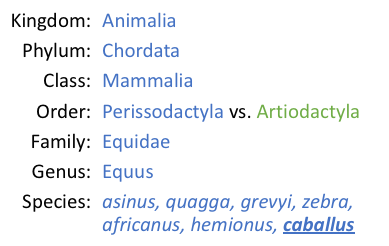Main Content
Lesson 3: Equine Science
Lecture 3: Equine Science
The videos and commentary on this page present information about the evolution of the horse over the last 60 million years, as well as defining exactly what we mean when we talk about equine science. Other topics covered are an introduction to the horse industry in Pennsylvania and some thoughts on how you might think about your own role in the horse industry.
Scientific Classification of the Horse
It’s useful to look at the horse and the scientific classification of the horse. You are not required to memorize the scientific classification. But, there are a couple of points to highlight.

Order
If we look at order, perissodactyla compared to artiodactyla, this is a place where the horse really stands out. The horse is perissodactyla. Horses have an odd number of toes and also tend to be hindgut fermenters. Whereas artiodactyla, such as the dairy cow or cattle, have an even number of toes and tend to be ruminant species.
Species
At one time there were actually a greater number of perissodactyla on planet Earth. In fact, when we get down to the level of species for the horse, there was a great number of different species of horse under certain environmental conditions. At the time in history when there were many, many more species of horse, the Earth had much more of a savannah or grasslands-type where there was a lot of grass available for animals to graze on. And the horse is very well adapted to that particular type of environment.
The gastrointestinal tract, the physiology of this animal, is adapted to a particular environment. That kind of knowledge and understanding can help us and inform the way that we keep the horse today in terms not only the best athletic production but also the best health of the animal.
Equine Evolution
View the Evolution of the Horse infographic shown in the video.
Mammals related to the modern day horse have been been present on our planet for close to 60 million years. An excellent overview of this evolutionary history of the horse can be found on this excellent interactive website at the Florida Museum of Natural History.
It is worthwhile to think about how different the environment that we keep the horse in today is from that to which it has adapted to over its evolutionary history.
- What implications might keeping a horse in such a different environment mean?
- Can you name at least 3 things that are significant changes from the natural environment of the horse in the picture to the left?
- How can equine management be improved based on knowledge of equine evolution?
Equine Science
You have an opportunity this week to comment on the “Equine Science – What is it?” post. Think about what has been presented in the Equine Science video clip in making your comments. Also consider all the places where science might play an important role in the equine industry. How will you use science in your career?
Equine Anatomy and Gaits
On a side note, check out this awesome animation clip created by animation students at Carnegie Mellon University. A stretch, but consider that an understanding of equine anatomy and gaits can even come in handy for an animation student!
Equine Science at Penn State
The Armsby Calorimeter was an important scientific tool used to study animal physiology and nutrition here at Penn State. Today the calorimeter is a museum and our Equine Nutrition class (ANSC 467) takes a tour of it each year.
Horses in Pennsylvania
Make sure you take a look at the “Outside Links” in the Syllabus module to explore some different aspects of the equine industry in Pennsylvania. Do you know of some other good websites for the horse industry in PA? Place them in your comments on the lecture for this week!
